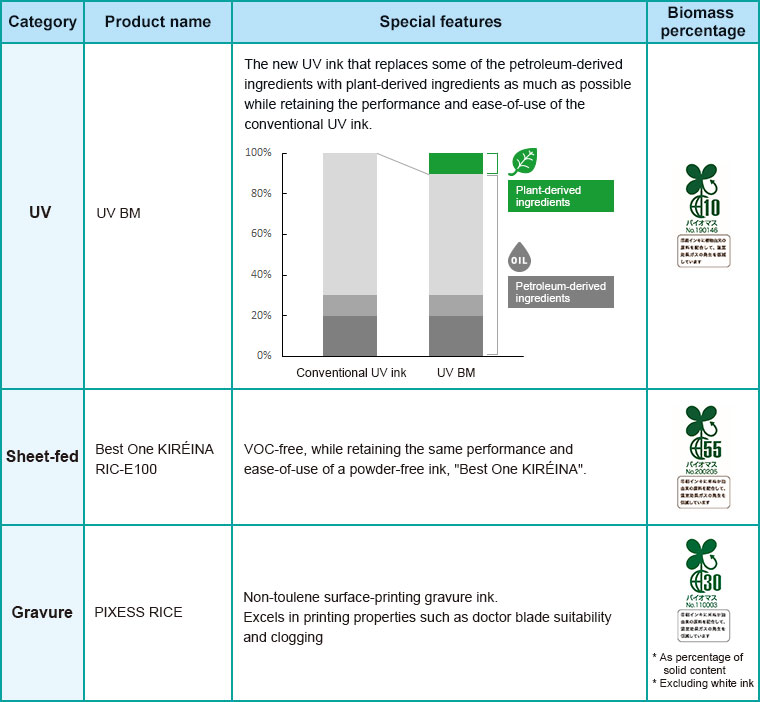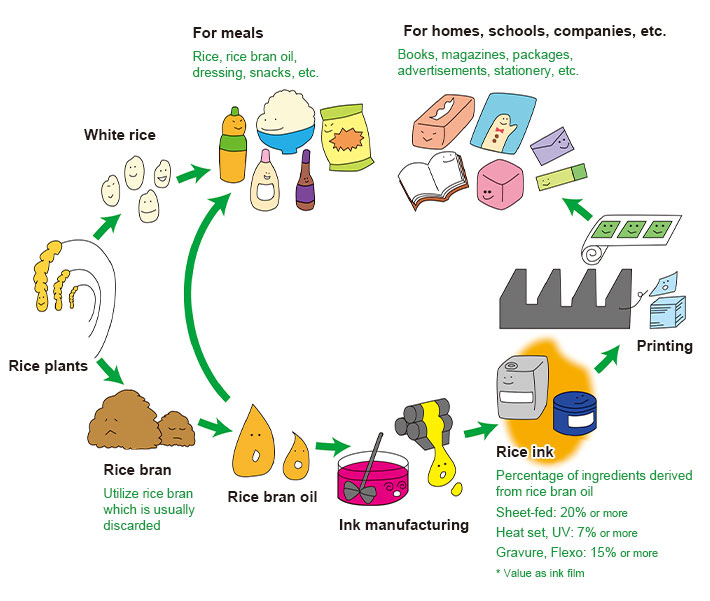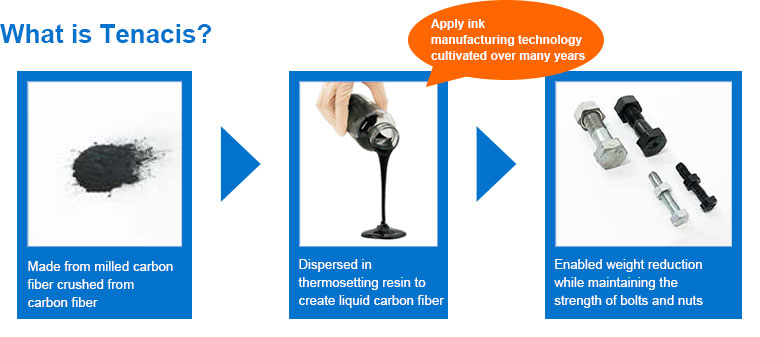Eco-Friendly Products
T&K TOKA has been developing eco-friendly products from the perspective of an ink manufacturer, which includes the use of sustainable resources made from biomass, energy saving, and the reduction of risks from chemical substances. We also apply the technologies we have developed in the field of ink to increase our offerings of eco-friendly products in fields other than printing.
UV Ink/Energy Saving Supersensitive UV Ink
Printed matter using oil-based ink requires considerable time as well as heat energy to dry. In 1977, T&K TOKA moved ahead of the times by succeeding in developing "UV (Ultraviolet) ink" which instantaneously hardens and dries by ultraviolet irradiation, aiming to improve production efficiency and saving energy used in the printing process. Furthermore, in 2008, we developed " low-energy curing UV ink " which hardens and dries by dedicated LED-UV irradiation equipment, succeeding in reducing the amount of electricity used in printing to less than 50% of the conventional "UV ink".
In order to provide "UV ink" with high printability, we spent more than 40 years focusing on improving not only drying but also technology that balances usability and print quality. This work enhanced our competitive position and led to increased business opportunities, and we now hold the number one share of the Japanese market for UV ink.

Biomass Ink/Rice Ink (Sustainable Use of Resources, Energy Saving)
Biomass is a renewable resource derived from plants and other materials. Inks often include petroleum-derived ingredients, but from the perspective of reducing environmental impact, "biomass ink", which replaces some of these with plant-derived ingredients like soybean oil, is common. On the other hand, from the perspective of securing stable food supplies in recent years, there are growing concerns about the use of edible soybean oil. Against this backdrop, in 2008, we developed "Rice Ink", which replaces a portion of the petroleum-derived ingredients with ingredients derived from rice bran oil. Unlike soybean oil for which Japan relies heavily on imports, "Rice Ink" uses oil made from rice bran which is produced domestically and has few other uses, leading to reduction of the energy required to import raw materials and waste. "Rice Ink" was initially used in food packaging for a major convenience store chain and its use has subsequently expanded.
Biomass Ink Lineup

T&K TOKA's Rice Ink
How Rice Ink is made from rice bran

Inkjet Printer Inks (Sustainable Use of Resources, Energy Saving, Reduction of Risks from Chemical Substances)
Printing with inkjet (IJ) printers does not require the making and cleaning of printing plates, which reduces the environmental impact of the overall printing process, and the demand for inkjet printers in on-demand printing is also growing because they are suitable for small-lot printing up to several thousand copies. Inkjet printers also contribute to enhance labor productivity because the printing can be done by the push of a button without an operator. We are developing the ink for UV inkjet printers, which contributes to energy saving in printing, and the ink for water-based inkjet printers that contains almost no organic solvents for use in flexible packaging for foods and so on.
Epoxy composition in which milled carbon fiber(MCF) are dispersed (Weight Reduction in Products Including Automotive Components)
Carbon fiber is a lightweight but sturdy material that contributes to improvement of energy utilization efficiency, and its use is increasing in airplane and automobile bodies and so on. Applying the dispersion and synthesis technologies we have cultivated through the development of printing inks and synthetic resin products, we developed "Tenacis", the world's first liquid carbon fiber. By solidifying the liquid carbon fiber, it is possible to make components with complex shapes that were difficult to produce with conventional carbon fiber. We are now developing applications for automotive components and medical devices.

